Here’s my third entry in the the Redistricting Plans From An Alternate Universe series. So far, we’ve seen the Veasey-West proposal and the Gallegos plan and Uresti amendment. Today I have what I consider to be the most interesting map I’ve seen. It was submitted by State Rep. Robert Alonzo during the House Redistricting committee meeting, and it’s Plan C142 on your scorecard. Let’s look at some pictures, starting with Alonzo’s home turf, the Metroplex:
Alonzo, like his neighbor to the west Marc Veasey, goes for two new Democratic districts in the Metroplex, one Latino and one African-American. Unlike Veasey, he does this by drawing a Republican out of a seat, in this case Rep. Kay Granger, whose CD12 would not be recognizable to her. His districts also appear to be more compact than Veasey’s. Now let’s look at Central Texas:
District 10 moves west, and may or may not contain Mike McCaul’s home precinct; off the top of my head, I just don’t know. It has about the same electoral profile as the current CD10. Once again, Lloyd Doggett gets restored to a Travis-centric district. CD34, about which you’ll see more in the next picture, wends its way south and takes up a chunk of Bexar County. CD27 comprises a fair amount of the old CD10, as well as some of the current CD14 – it goes down to the coast and also picks up most of northern Brazoria County. CD22 shifts northwest to swipe Austin and Waller Counties from the old CD10. Now let’s look south from here, starting with the Bexar County area:
CD28, which once had a small piece of Bexar and included counties like Guadalupe and Wilson, shifts south and west, while CD23 goes south. Continuing south, here’s what we see:
I guess it’s fajita strips forever, but they do get a new district, CD33, in the bargain. Finally, let’s look at the Harris County area:
It’s so different I almost don’t know where to begin. Pete Olson would have to move, as Clear Lake is no longer in CD22. So would Ron Paul, as Matagorda County is now in CD27. John Culberson gets banished to the northwest corner of the county, which would make him safe for the decade and would remove his influence over the Universities light rail line. CD36 is new, and may be the single most interesting district I’ve seen proposed by someone with skin in the game. To see why, let’s look at the electoral numbers:
Safe R Dist Obama Houston ======================= 01 30.65 36.37 02 29.72 35.54 03 37.68 37.02 04 33.10 35.39 05 28.83 38.38 06 35.42 36.76 07 30.96 31.84 08 25.90 30.11 11 22.40 28.07 13 22.87 28.50 17 34.69 39.78 19 27.87 31.94 21 32.53 31.71 22 36.25 36.00 24 37.05 36.92 26 31.42 32.66 27 34.08 38.66 Likely R Dist Obama Houston ======================= 10 44.82 42.96 14 42.06 49.08 31 42.57 42.57 32 42.11 42.09 Lean D Dist Obama Houston ======================= 36 51.92 52.53 Safe D Dist Obama Houston ======================= 09 71.37 70.78 12 68.37 68.81 15 56.61 60.86 16 64.15 66.29 18 73.44 72.95 20 58.63 58.60 23 59.00 60.86 25 71.96 69.07 28 58.48 62.64 29 60.80 66.47 30 71.51 72.23 33 58.42 62.35 34 59.18 61.31 35 64.07 65.29
Yes, that’s a genuine swing district. Every Democrat won it in 2008, every Democrat other than Bill White lost it in 2010; the high D score on the statewide ticket was Bill Moody’s 45.58%, with David Porter’s 51.66% being the low R score. I’m sure a couple of countywide Ds did better, but I don’t have those numbers, and I doubt they would have won it anyway. In a more normal non-Presidential year, it would likely be a slightly lean-D district, but it’s not out of the question that you could see it flip back and forth every other year. What’s even more curious to me is that it’s not drawn as a Hispanic opportunity district; the SSVR there is 23.4%. I’d love to know what motivated Alonzo to draw this particular seat. With all four of the new districts going to the Ds, plus the two takeaways (Granger and Canseco; Farenthold might have to move to get into the new CD27), Alonzo’s plan would make the split 21-15 in favor of the Rs. Well, it would have, if it hadn’t gotten voted down along predictably partisan lines, along with Veasey’s plan and a bunch of other Democratic-drawn maps. Still, you can see a full spreadsheet from 2008 here and from 2010 here. What do you think of Alonzo’s plan?

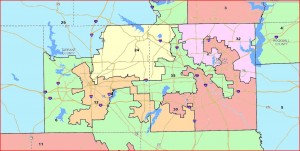
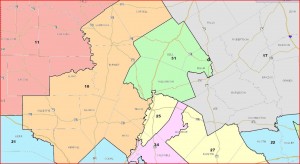
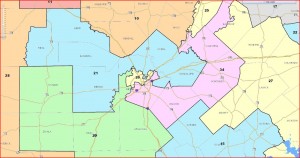
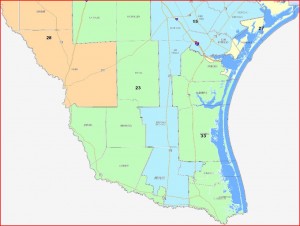
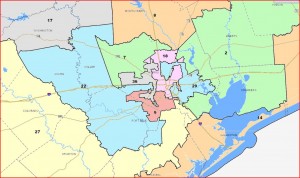
Of course they are going to the courts, and Solomons et al. knew that all along. The question that I’ve wondered is whether a deal could have been reached to avoid the courts. The Democratic maps, like Alonzo’s, seem to have drawn 14 solid Dem seats each, while Solomons-Seliger draws 10. Could they have avoided a court case with say 12?